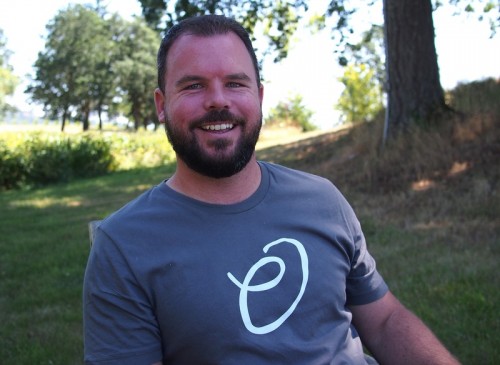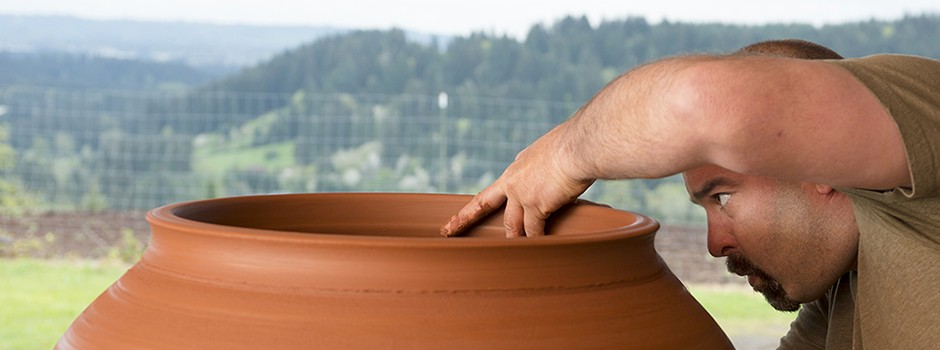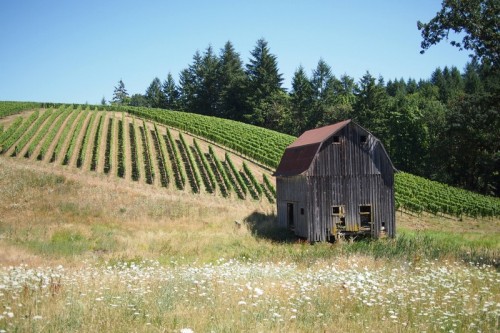Generalization is necessary to the advancement of knowledge; but is particularly indispensable to the creations of the imagination. In proportion as men know more and think more they look less at individuals and more at classes. They therefore make better theories and worse poems. –Thomas Macaulay
Marketing wine depends on presenting generalisations as inalienable truths (that’s a generalisation in itself). Each country, each region, each vineyard is the aggregation of countless tales of individual endeavour. This is what lends wine its particular poetic enchantment.
Individual approaches naturally yield different stylistic outcomes. One such is to source interesting grapes from discrete regions and to interrogate the outer limits of textures and flavours in wines.

(photo by Wine Anorak)
To this end Chad Stock has created two parallel projects – one that allies specific grapes to specific (lesser-known) Oregon terroirs, the other is a fusion of ideas, wherein the juice is the potential to be worked and shaped in particular ways. In his “Numerical Series” Chad probes boundaries by experimenting with flor-ageing, oxidative techniques, reduction, extended skin maceration as well as fermenting and maturing in a variety of formats including amphora, chestnut and different shapes and sizes of oak.

In this respect Chad is not so different to Austrian vignerons such as Martin Arndorfer, Claus Preisinger and Franz Weninger, all of whom are looking to push their wines in various directions, to play with textural options, whilst harnessing the energy of their respective terroirs (Chad’s wines are all single vineyards). Working with minimal or zero chemical additives is not the same as non-interventionism; the warp and weft of the wine is very much dictated by idiosyncratic choices in the winery. This is the antithesis to the more classic Oregon stylistic notion that wine adhere to a common denominator varietal (one particular varietal) style by being vinified and aged in a highly specific fashion. You understand that winemaking is about brokering a consistent approach. Our Austrian growers are capable of following two seemingly contrary approaches– the one which respects the tradition of the varietal and the one which expresses the a deep inner desire to “rebel”. Judith Beck has her Bambule! range, Martin Arndorfer has his Per Se wines whilst Alwin Jurtschitsch experiments with his wild Entdeckungen variations. In each successive vintage you notice how these progressive styles are slowly and subtly leaching into the more traditional wines.
These wines make you sit up and take notice. They challenge and arouse your palate. Received wisdom dictates that the job of the vigneron is to avoid a situation where the problematic by-products of the transformational process totally subvert the expression of fruit or terroir. Yet I have witnessed a wine evolve from ugliest duckling into comeliest swan when these so-called faults (stinky compounds) have dissipated. Go figure. So, although one might argue that, while there are some absolutes in wine assessment, there are many more relatives and exceptions that may or may not prove the rule. As drinkers we perhaps should examine wine holistically, deploying ethical, aesthetic, sympathetic and analytic sensibilities and formulate a response accordingly, rather than filtering the wine through a single thick gauze of received wisdom.
Flaws in wine are a kind of counterpoint; they highlight or accent the quality of the wine itself such as a strange note in a musical composition, a crack in the paint on a canvas or a dent on the surface of the apple. Flaws are the warp and the weft, the living truth of the wine, “the bottled poetry” that Robert Louis Stevenson refers to, and testament to its mutability.
This truth feels like Wabi sabi, the ancient aesthetic philosophy rooted in Zen Buddhism, particularly the tea ceremony, a ritual of purity and simplicity in which masters prized bowls that were handmade and irregularly shaped, with uneven glaze, cracks, and a perverse beauty in their deliberate imperfection.
The philosophy celebrates beauty in what’s natural, flaws and all. The antique bowls above are prized because of (not in spite of) their drips and cracks. Wabi sabi is the beauty of things imperfect, impermanent, and incomplete, the antithesis of our classical Western notion of beauty as something perfect, enduring, and monumental.” In wine, cleanliness may be next to godliness if you are an oenologist, but it may also result in antiseptic, denatured, faultily-faultless wines. Wines that have edges and abrasions, raggedy wines that possess their own remarkable inscape – to use a term coined by Gerard Manley Hopkins – seem to be more human.
Modern palates cleave to recognizability – as soon as you confront people with something that is notionally blemished, say a Sauvignon that is almost amber in colour and has no obvious fruity aromatics, or tannins in a white wine when you are expecting clean and cleaned-up juice, they are disconcerted for they have been taught to believe that these are deviations from the norm. Such templates need to be shattered as they are about technique rather than terroir or singularity.

Jeff Vejr curates some of the most exciting and original restaurant wine lists you will ever see. He is also fascinated by the stories behind the wine and is involved in the kind of wine archiving that we have seen in Georgia (most obviously), in Gaillac by the Plageoles family, in Languedoc with Thierry Navarre, or in Alicante with Rafa Bernabe, not just preserving the heritage per se but also understanding the potential of grapes that have once been (and could still be) planted in certain regions. Throughout the wine world the autochthonous has been supplanted by international varieties as growers deem it necessary to adopt a safety-first-follow-the-trend approach. Oregon so much specialises in a varietal – Pinot Noir – and all the talk is of clonal selection and vinification methods – perfecting the flavour of the wine. What I loved about Jeff’s Golden Cluster Semillon, as well as its unusual mineral flavour, is that the wine has a distinct link to the past, to Charles Coury, one of Oregon’s wine pioneers. You don’t have to have 2,000 years of wine history to have a proud wine culture; it is more about valuing what you do have.
There are as many different road journeys as there are individuals to make them.
Then took the other, as just as fair,
And having perhaps the better claim
Because it was grassy and wanted wear,
Though as for that the passing there
Had worn them really about the same,
And both that morning equally lay
In leaves no step had trodden black.
Oh, I kept the first for another day!
Yet knowing how way leads on to way
I doubted if I should ever come back.

Andrew and Annedria Beckham originally started along a well-trodden path and then forked into lesser-charted wine territory. Andrew, a potter who teaches ceramics at the local college in the spare time which you can’t believe he has any of, makes amphorae, and recently began to make wine to go into amphorae. His learning curve has been very steep. The effect of fermenting in clay, for example is startling and goes against the oaked grain of typical Oregon wine. The resultant wines assume a different timbre; clay-fermented Pinot Noir, for example, is lighter, rounder and more floral, qualities even more accentuated when the wine also matures in the amphora. Andrew explained that the nature of the fermentation (the speed, the exchange) in clay substantively alters the texture of the wine. What was also evident to me was the difference between maturing the wine in clay and oak barrels (or even acacia). The relatively naked Pinot takes on the oak influence that much more and the fruit begins to move to the darker end of the spectrum – even the colour changes noticeably, whereas the all-clay versions are more aerial and red fruited. These are questions of style rather than correctness.

Scott Frank makes his wines in a former bookbinding factory in Portland. He has a feel for what he wants in his wine – which is limpidity incarnate. He wants to make Loire-style wines. To do that he has to capture that sensation of cool fluidity in his reds. Good farming helps as do gentle (non-extractive) ferments (Scott uses large cement vats). The fruit presents as red fruits over stone with some floral grace notes. Typical Oregon wines? No… and yet, yes. In a way we should stop asking that question. When you are Kelley Fox you are farming in the very particular vines of Maresh or Momtazi. There is a natural urgency in these places that begs to be respected.
If you believe that wine is a perfectible product then you may wish to generalise. Talking to women and men who work artisanally in the vines and then in the cellar you pick up on some common themes. Firstly, that the vigneron doesn’t invent. He/she listens. To nature. To the wine. Secondly, that vignerons don’t make wine as such. They unravel nature’s handwriting and then tie it up again, but differently. Thirdly, that a vigneron at ease with his/her craft never strains to make the wine more beautiful. Neither does a nursery gardener scent his roses.
Like their vines growers eventually put down own roots. Those roots are most entrenched when they feel free to follow their own path, to find their own inner voice in the wine itself. It is as if they are part of the process rather than controlling the process ab ovo usque ad mala. This independence needs nurturing on occasion; in every country and region there are mentors, selfless people who lend their knowledge and wisdom to others.
In Austria the family units are strong; indeed families remain in the same village as mutual support networks. This creates a sense of belonging: “A sense of place results gradually and unconsciously from inhabiting a landscape over time, becoming familiar with its physical properties, accruing history within its confines.”

(photo by Wine Anorak)
In Oregon, meanwhile, I met individuals who had been drawn to a place by their love of wine. And, of course, their love of the place. The consequent interactions in the vineyard are special; the rhythms of nature absorbed into the rhythms of the life as a vigneron.
When we drink wine we are looking for an attachment to a place and a time – and the individual who mediates between place, time and wine. There is a saying that if you don’t know where you are, you don’t know who you are.
Nature comes home to one most when he is at home; the stranger and traveller finds her a stranger and traveller also. One’s own landscape comes in time to be a sort of outlying part of himself; he has sowed himself broadcast upon it, and it reflects his own moods and feelings; he is sensitive to the verge of the horizon: cut those trees, and he bleeds; mar those hills, and he suffers. How has the farmer planted himself in his fields; builded himself into his stone walls, and evoked the sympathy of the hills by his struggle! -John Burroughs

